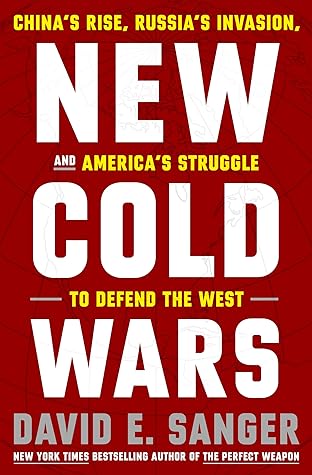More on this book
Community
Kindle Notes & Highlights
Read between
June 7 - September 5, 2025
On a trip to Ukraine in the beginning of 2023, a group of White House and State Department officials were shown how Ukrainian soldiers brought a 3D printer to the rear lines of the battlefield to replace worn-out parts for an artillery battery, rather than send the whole battery back to Poland for repair. The Ukrainians designed a tank-killing drone that cost roughly five thousand dollars each and then worked on swarms of far cheaper ones meant to overwhelm Russian air defenses. “Ukraine is, in a very rapid environment, in two to three years, inventing stuff that will take thirty years to be
...more
The economic outlook was similarly bleak. One of the remarkable diplomatic accomplishments during the first year of the war was that Ukraine was still able to export grain—with Russia’s reluctant acquiescence—under the Black Sea Grain Initiative. That arrangement, brokered by Turkey and the United Nations in the early days of the war, assured that wheat shipments from both Russia and Ukraine—two of the world’s largest exporters—could continue.
she told me in September, “I’m changing the goalposts.”
In an instant, almost everything the world had come to take for granted about the omnipotence and competence of Israel’s security institutions seemed wrong. Its intelligence services had failed to recognize the significance of the months or years of planning and the deliberate dismantling of the digital surveillance infrastructure around Gaza. The barriers that protected Israelis from underground tunneling were useless against terrorists using gliders to fly over them and bulldozers to knock down fences. The Israel Defense Force was pitifully slow to respond. “On that fateful day, the
...more
The outlines of this new era are slowly beginning to take shape. Globalization is out; self-reliance and control of a nation’s own supply chains are in. Nationalism is back in vogue, and so are the strongmen who preach it. North Korea and Iran are now military suppliers to Russia and increasingly in alignment with China. The partnership that Xi and Putin celebrated at the opening of the Olympics is stronger than at any point since the Korean War. Putin’s threat to deploy battlefield nuclear weapons to deter other countries from aiding Ukraine risks inspiring other nuclear-armed autocrats.
...more
Putin’s forces had been battered by more than three hundred thousand casualties. More important, Ukraine had held its own. Yet for all its successes, it appeared to have little prospect of driving Russia completely out of its territory any time soon. After two years of war, Putin’s military was finally beginning to make good use of technologies it had invested in for years, starting with electronic warfare. More strikingly, he turned sanctions evasion into an art form, and then into a profitable enterprise, by seizing the assets of fleeing Western companies and generating over a billion
...more
In the next few years, three immediate risks seem likely to dominate America’s dealings with Xi’s government. The first is that a future U.S. administration will abandon our current technology strategy, despite early signs that it is beginning to work. So far, the aggressive mix of investment in developing key technologies at home with increasing control of sensitive exports to Chinese firms has prompted Xi Jinping’s strongest protests. The danger is not simply a reversal of the strategy, but a failure to drive it further forward.
The second risk is that Washington could go too far with its sanctions and tariffs, and thereby play right into Xi’s argument that America’s real goal is “containment, encirclement, and suppression.” Not every Chinese advance is a Sputnik moment. When China masters the technology to manufacture chips with three-nanometer circuits or celebrates a leap in artificial intelligence or space launches, there will be calls to react and, most likely, overreact. The better approach, striking a balance, requires understanding which technological advantages Americans need to protect and which are less
...more
The third risk is that, through some combination of America’s overheated rhetoric and its enthusiasm for new sanctions, America and its allies unintentionally drive Russia and China closer together. Washington already has a severe case of anti-China animus, bordering on unchecked xenophobia. As elections approach, there is no easier political target than the Chinese Communist Party. At the end of 2023, there was talk among some in Congress that the combination of Russia and China, along with Iran, constituted an “axis of evil” that America needed to “deal with.” (It was never made clear what
...more
One of the most vivid lessons of the war in Ukraine is that moving the country’s government operations to the cloud was worthless without a hard-to-jam communications network that kept the country running; that was Starlink, with its network of nearly five thousand satellites. China’s plan for a future conflict with the United States, if it comes to that, is to blind American forces, from our aircraft carrier groups to our nuclear submarines. Even now, China is inserting code into American power and water supply systems, presumably to slow a response if a Taiwan crisis erupts.
NAVIGATING THIS NEW period will be especially fraught. Three major powers—and dozens of smaller ones—maneuvering for simultaneous advantage create far more potential for conflict, both accidental and deliberate, than the world has confronted before. Ours is an era that has echoes of the early days of the Cold War—and of the period of open great power competition that preceded the First World War—and carries with it all the fears of escalation that underpinned that age and the devastation that followed. For all the present risks, it is worth remembering that one of the most remarkable and
...more


